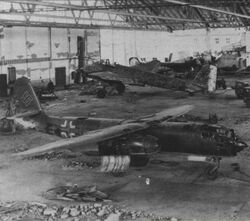The Arado Ar 234 was a jet-propelled medium bomber and reconnaissance aircraft that was used by Germany during World War II. It was the first operational jet bomber in the world at the time and it was also one of the fastest ever built.
Description
Once airborne, Allied interceptors which were usually slower than the Ar 234, had extreme difficulty trying to catch up, which was a similar result with the Messerschmitt Me 262 and Me 163 fighters. The Arado Ar 234B-2 had a crew that consisted of only one man and an armament that up to 1,500 kg worth of bombs.[1]
The first production model of the Ar 234 series, was the Ar 234B model. It had two Junkers Jumo 004 Engines, with an internal supply in the B-2 of 835.9 Imp Gals/1,003.85 US Gals/3,800 litres of fuel,[2] that were capable of propelling it at speeds of up to 742 km/h. The total weight of the Arado Ar 234 was about 9,800 kg when loaded with equipment and the total length was about 12.6 meters.[3] The service ceiling of the Arado was around 10,000 meters and it a maximum range of 1,500 kilometers. Unlike it's earlier prototypes, the Ar 234B sported a tricycle undercarriage for landing and take off instead of the original skis, which had proved to be extremely unreliable. Additionally, to assist in take off, some Arado Ar 234s had rocket boosters mounted, in order to gain speed.
Variant
The first variant of the Arado Ar 234 series was the Arado Ar 234B-1 which was fundamentally the same as the original model only it had its weapons removed and replaced with reconnaissance equipment. The next variant, the Ar 234B-2 was an improved bomber with more powerful engines and an increased bomb load. Based on this improved platform, the Ar 234B2/b was again fitted with reconnaissance equipment.

An Arado Ar 234 still under construction when captured
The Ar-234C was the next highly significant variant, it was a multi-role aircraft with a pressurized cockpit and ejection seats. Also notable in its design was the addition of two more turbojet engines.[4] As was mentioned, the Ar 234C model was multipurpose and could fulfill a multitude of tasks. The ground attack version of the C model was designated the Ar 234C-4 while the armed reconnaissance model was designated the Ar 234C-2.
History
The Arado Ar 234 was derived from Walter Blume's 1941 Project E.370, which used a set of sprung skids resting on a jettisonable 3 wheel trolly, thus allowing more fuel to be carried. in order to increase the range of the aircraft. However, following problems with the trolly, and the realisation that the skid undercarriage would make the aircraft vulnerable due to impaired ground handling, it was decided to redesign the aircraft with a conventional retractable tricycle undercarriage.[5]
Eventually developed in 1943, as part of Germany's very successful turbojet project, it was later released to the front-lines a year later in July, 1944. It's early missions were nothing more than basic reconnaissance, most notably over Great Britain. After reconnaissance roles, the aircraft became a dedicated bomber platform, being used for the first bombing raid by jet aircraft, when nine Ar 234B aircraft from 9 stafell KG 76 bombed Liege on Christmas Eve 1944,[5] as well as in the latter battles of World War II, such as the Battle of the Bulge. In total, about 270 Ar 234s were produced by the end of the war, in 1945.[6]
At least nine examples were flown to the UK for evaluation by the RAF,[7] with other examples going to the United States of America for evaluation at Wright Field[8] and the US Navy test centre at Patuxent River.[9]
References
- ↑ http://www.militaryfactory.com/aircraft/detail.asp?aircraft_id=101
- ↑ Chant, Chris. German Warplanes of World War II. 1999. Spellmont Ltd. ISBN 1-86227-049-X Page 8
- ↑ http://www.ww2warbirds.net/ww2htmls/aradar234.html
- ↑ http://www.warbirdsresourcegroup.org/LRG/ar234.html
- ↑ 5.0 5.1 Take Off magazine. Aerospace Publishing Ltd. 1994-1996. Air Combat - issue 79
- ↑ http://www.wwiivehicles.com/germany/aircraft/bomber/arado-ar-234.asp
- ↑ Brown, Eric Melrose. Wings of the Luftwaffe. The Crowood Press Ltd - New edition (14 Feb 1998). ISBN 1853104132. Page 94
- ↑ Brown, Eric Melrose. Captions for photos on pages 98 & 99
- ↑ Brown, Eric Melrose. Caption for photo on page 102
| ||||||||||||||||||||||||||
